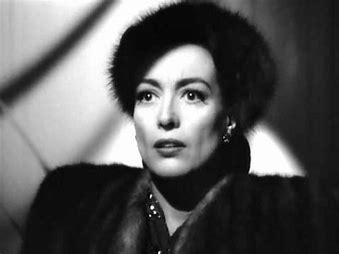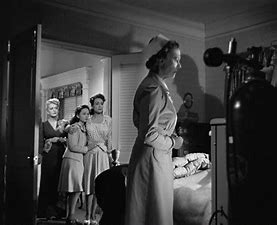DIRECTOR: Michael Curtiz
BOTTOM LINE: Joan Crawford plays Mildred, and Ann Blyth plays Veda, the most ungrateful daughter in Cinema history in “Mildred Pierce,” director Michael Curtiz’s masterful adaptation (from an Oscar-nominated script by Ranald MacDougall and several other uncredited writers) of the 1941 novel by James M. Cain. It was Crawford’s first starring role for Warner Bros. after leaving MGM, and she deservedly won the Academy Award for Best Actress of 1945.
“Pierce” is the centerpiece of the mid-1940s Cain triptych, the other two movies being Billy Wilder’s Double Indemnity (film number 12, above), produced at Paramount in 1944, and Tay Garnett’s “The Postman Always Rings Twice,” produced at MGM in 1946. All three movies are characterized by plots that hook you immediately and superb acting.
The film opens with the murder of Monte Beragon (Zachary Scott), Mildred’s second husband. The police tell Mildred that her first husband, Bert Pierce (Bruce Bennett), is guilty of the murder because he owns the gun, has a motive, and does not deny the crime. Mildred protests that he is too kind to commit murder and begins to tell her story to the officer.

LIKE MOST OF THE GREAT FILM NOIRS FROM THE FORTIES, “MILDRED PIERCE” THEN PROCEEDS WITH CRAWFORD’S NARRATION AND THE NARRATIVE UNFOLDS IN FLASHBACK
Mildred and Bert Pierce are an unhappily married couple living in the LA suburb of Glendale, California. After Bert splits with his business partner, Wally Fay (Jack Carson), Mildred must sell her baked goods to support the family. Bert accuses Mildred of favoring their two daughters over him. Their quarrel intensifies after a phone call from Bert’s mistress, Maggie Biederhof (Lee Patrick), and they separate.
Mildred retains custody of sixteen-year-old Veda (Blyth), a bratty social climber and ten-year-old Kay (Jo Ann Marlowe), a genial tomboy. Because they live in working-class Glendale, as opposed to the more sophisticated, adjacent Pasadena, Veda lives her life in a constant state of shame and has to be placated by a stream of material possessions by Mildred, who gets an additional job as a waitress which she hides from Veda. However, Veda learns the truth and treats her mother with contempt.
Mildred meets the wealthy Pasadena playboy Monty Beregaron and, although she does not love him, marries him so that she can open what turns out to be a highly successful chain of chicken-and-waffle restaurants called “Mildred’s” which she runs with her good friend Ida, beautifully played by Eve Arden in her only Oscar-nominated role. Because of Arden’s unique delivery, Ida becomes, both literally and figuratively, the film’s voice of reason.
All of Mildred’s Herculean efforts are to please Veda, but she is betrayed at every turn.

Brilliantly filmed in high Germanic style by a wondrously talented bunch of ex-pat Viennese uber talents (in addition to Curtiz, we have the production design of Anton Grot and one of Max Steiner’s great scores) – plus the stunning black-and-white cinematography of Ernest Haller – “Mildred Pierce” is one of the great film noirs of the forties.
Although there is no identifiable gay character, Curtiz’s presentation of high melodrama bordering on camp makes “Pierce” a Querr Film par excellence. And gay actor Zachary Scott, whose Hollywood career suffered because of his sexual orientation, gives Monty a fey touch, always raising the possibility that his sexual proclivities also extended to men.
I also love “Mildred Pierce” for its lack of subtlety in the health department. Watching it reminds me that when a character coughs, even just a single cough, in a pre-1960 Hollywood movie, you know that they will be dead in the next scene or certainly in the scene after that. Remember poor Elizabeth Taylor in “Jane Eyre”. From that first delicate hack, you knew she was a goner.
This scenario plays out in “Pierce” with Kay, the good daughter. With just one cough, we know that Kay’s fate is sealed and that her chances of surviving the trip to Lake Arrowhead with Veda and Bert, are slim!
Astonishingly, she does make it back to Glendale – but in an oxygen tent! This allows Curtiz to set up one of the most memorable scenes in the movie. When poor Kay takes her last breath, even before Mildred or Veda has time to react, the nurse rushes to turn off the precious oxygen supply.
This scene never ceases to send me into paroxysms of laughter. However, I never stop caring. Like Robert Aldrich’s “Whatever Happened to Baby Jane,” “Mildred Pierce” plays as drama and camp simultaneously with no dichotomy involved. And for that, I am always grateful.
NOW STREAMING ON AMAZON PRIME VIDEO, APPLE TV+,, YOUTUBE
https://thebrownees.net/sixty-six-queer-films-made-under-the-hays-code-1934-1967
https://thebrownees.net/sixty-six-queer-films-made-under-the-hays-code-1934-1967-table-summary
https://thebrownees.net/fifty-two-post-hays-code-queer-films-released-in-the-decade-1967-1976
The Great Cinematographers of Hollywood’s Golden Age – TheBrownees


















